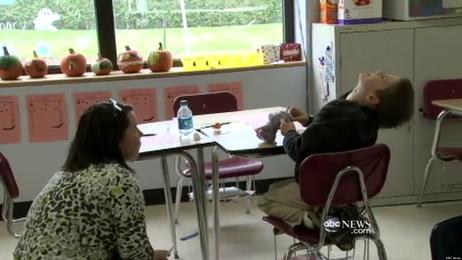Despite our modern approach to education, physical discipline is still being used in public school classrooms in America. Parents nationwide are expressing concern over the use of seclusion and restraint in public school classrooms. A report from the U.S. Government Accountability Office, released in May 2009, revealed that between 1990 and 2009, there had been “hundreds of allegations” of abuse involving restraint or seclusion, according to USA Today. In Texas and California alone, a combined 33,095 students were secluded or restrained in the school year leading up to the report’s issuance.
Restraint Practices
The restraint practices described in the May 2009 report could sometimes verge on what could be called child abuse. Restraint practices are commonly used to deal with students who have behavioral or emotional problems.
In one New York school, a 9-year-old with learning disabilities was confined to a “small, dirty room” 75 times over the course of six months as a consequence of his “whistling, slouching, and hand-waving,” reports the USA Today. Meanwhile, in Texas, a 14-year-old boy who would not stay seated in his special-education classroom died when his teacher restrained him by lying on top of him.
This video looks at the issue of restraint and seclusion.
Lack of Regulation
According to concerned parents, there is a lack of federal and state regulations addressing seclusion and restraint practices in public schools. In May 2009, USA Today reported that only seven states had laws requiring educators to be properly trained before they are allowed to physically restrict children.
However, this situation may soon change, as both state and federal legislatures are taking steps to address this disturbing problem.
The recently issued 2010 “School is Not Supposed to Hurt” report from the National Disability Rights Network indicates that over the course of 2009, in response to increasing public awareness of the problem of excessive use of restraints and seclusion in schools, six states either passed new laws or strengthened existing rules and regulations concerning the use of seclusion and restraints. The states commended by the report for either creating new regulations or statutes or strengthening existing regulations are Minnesota, Missouri, Tennessee, Colorado, Pennsylvania, Maine, and Nevada.
This video discusses controlling an angry student.
Increased Federal Regulation of Restraint and Seclusion Could Be on the Horizon
Fortunately for those who are concerned about the lack of federal guidelines addressing seclusion and restraint practices in public school classrooms, a new bill currently working its way through Congress would establish “minimum safety standards” in schools, similar to established safety standards for restraint and seclusion that hospitals and residential treatment centers are already required to follow. The bill, called the Preventing Harmful Restraint and Seclusion in the Schools Act, would also:
- Require each state to establish its own standards for restraint and seclusion practices within two years of the bill becoming law
- Ask states to implement better training programs for school staff who may be called upon to restrain or seclude students
- Increase transparency and oversight by requiring states to collect and report data concerning restraint and seclusion to the Secretary of Education and authorize the Secretary of Education to withhold federal education funds from schools that did not establish policies and procedures that met federally-established minimum standards
In December 2009, Secretary of Education Arne Duncan issued a letter to the chairman of the committee responsible for developing the bill, outlining the Department of Education’s beliefs about what the new legislation should do. Federal legislation should assure, Duncan’s letter says, that physical restraint and seclusion “should never be used as punishment” and that any use of restraint or seclusion is “consistent with the child’s right to be treated with dignity and to be free from abuse.”
Alternatives to Restraint and Seclusion
Many parents who learn that their children have been physically restrained or secluded at school wonder if such drastic measures were necessary. In Kentucky, the Department of Education is taking steps to train its teachers and school support workers in an alternative to seclusion and restraints.
The alternative program is known as Positive Behavior Intervention and Support (P.B.I.S.) , and as Kentucky public radio station WKMS reports, the Kentucky Department of Education’s public relations officer, Lisa Gross, says it is a viable alternative to the use of restraints. The Kentucky Center for Instructional Discipline has already begun providing training in the new behavior management program in hundreds of schools across the state.
This video looks at alternatives to the use of restraint in classrooms.
While disability rights groups and parents across the country await the results of Congress’ deliberation over the new legislation, they can also hope that more states will follow Kentucky’s model and take steps to implement alternative behavior management systems that are safer and more humane than restraints and seclusion.
Questions? Contact us on Facebook. @publicschoolreview












